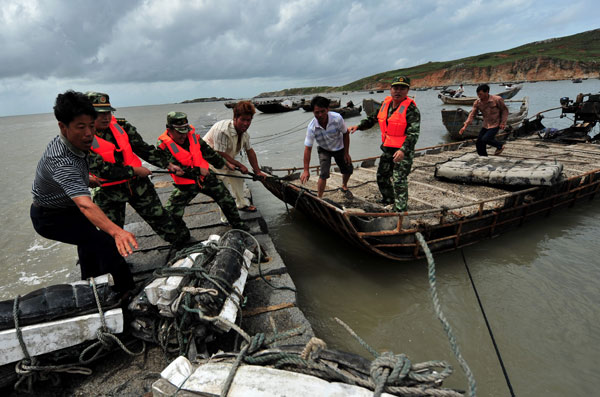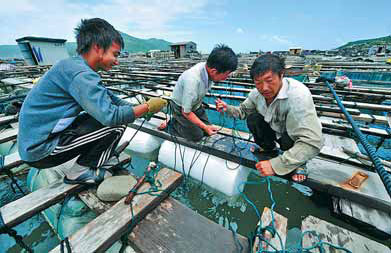
|
 Border guards help fishermen secure their boats at a port in Fuqing, Fujian province, on Tuesday. Tropical storm Saola is expected to hit Fujian and Zhejiang provinces on Thursday or Friday.?[Photo by Xinhua] |
Two typhoons will challenge the country's flood control capabilities in coming days, as many regions are now suffering from torrential rains and floods, authorities said.
Heavy rains brought by Saola, the ninth typhoon of the year, are expected to hit coastal areas in Fujian and Zhejiang provinces on Thursday or Friday accompanied by strong winds. The 10th typhoon, named Damrey, may affect Jiangsu and Shandong provinces on Friday, Chen Zhenlin, spokesman for the China Meteorological Administration, said on Tuesday.
The winds could reach 51 kilometers per second when the center of Saola passes the coastal areas, he added.
The two typhoons may cover more than 10 provinces in the country, according to the State Flood Control and Drought Relief Headquarters on Tuesday.
The headquarters urged its local branches to make full preparations to respond to possible disasters brought by the typhoons.
On Tuesday, the headquarters sent four work teams to affected provinces and cities, such as Fujian, Zhejiang, Jiangsu and Shanghai, to prepare for potential damage caused by the typhoons.
"Some major rivers in China, such as Haihe River, Yellow River and Huaihe River, have experienced severe floods in summer time over the past few decades because of the combined impact of typhoons and cold air," the headquarters said.
"Many local residents and government officials in North China do not have much experience in preventing disasters from typhoons. Also, providing timely protection to a great number of tourists stranded in coastal cities is another big challenge," it said.
Entering the flood season in June, the country saw an average precipitation volume of 232 millimeters as of Monday, about 11 percent more than the level in the same period since 1981, according to statistics from the meteorological administration.
"Global warming partially triggered the abnormally rainy summer this year," Sun Chenghu, senior engineer of the National Climate Center, said, adding that global warming increases the water content in the atmosphere and activates the cold and warm air movement.
 |
|
Fishermen fasten their traps in preparation for typhoon Saola in Pingtan, East China's Fujian province, on Tuesday. Zhang Guojun / Xinhua |
The increasing moisture and active air movement caused frequent rainstorms this summer, he said.
For instance, Beijing is facing the wettest summer since 1999, according to the meteorological administration, with about 63 percent more rain in June and July than the average level from 1981 to 2010.
According to China Three Gorges Corp, water was released from the Three Gorges Dam at a rate of 43,700 cu m per second on Tuesday afternoon in an effort to reduce the flood risk on the upper reaches of the Yangtze River.
Zhang Genxi, a local flood control official in Jingzhou, Hubei province, told China Daily on Tuesday that the city now is safe, but has been under great pressure to control floods for a long time.
The city, about 220 km from Wuhan, the provincial capital, is traversed by the Jingjiang River, a section of the Yangtze River, and has long been regarded as a key flood control region.
"Some river sections in Jingzhou have seen water level exceed the warning level since July when floods released from the Three Gorges Dam pushed them up," he said.
At present, more than 32,000 local residents and flood control officials are busy monitoring the flood situation day and night and are dealing with any disasters triggered by floods, he said.
Torrential rains in Southwest China's Yunnan province on Tuesday morning left 11 people missing, the provincial authorities said.
In the coming 10 days, rain belts will remain in the northern parts of the country with a maximum precipitation volume of 200 mm expected in parts of Liaoning and Inner Mongolia, Chen said.
Contact the writers at jinzhu@chinadaily.com.cn and wangqian@chinadaily.com.cn







